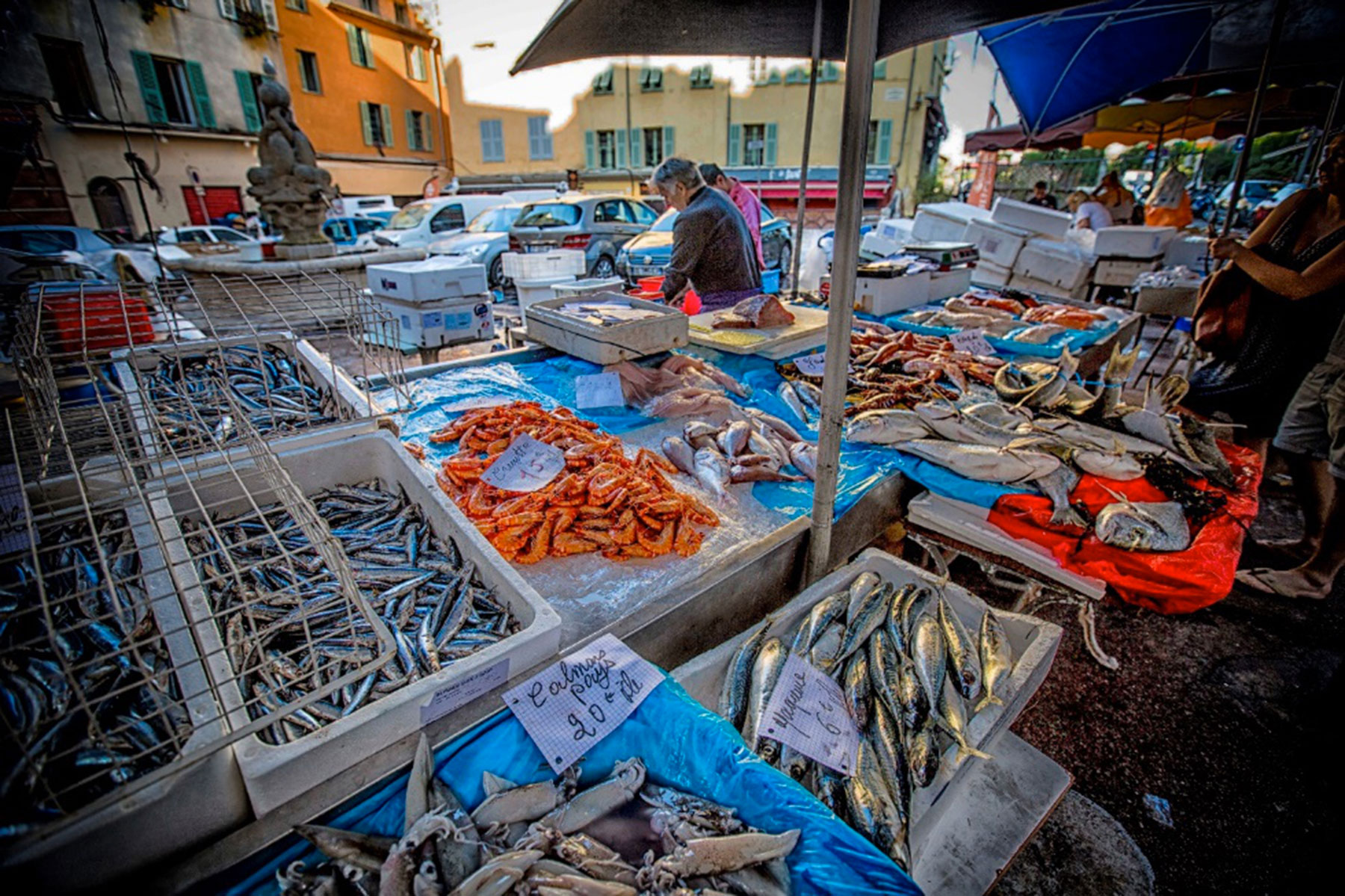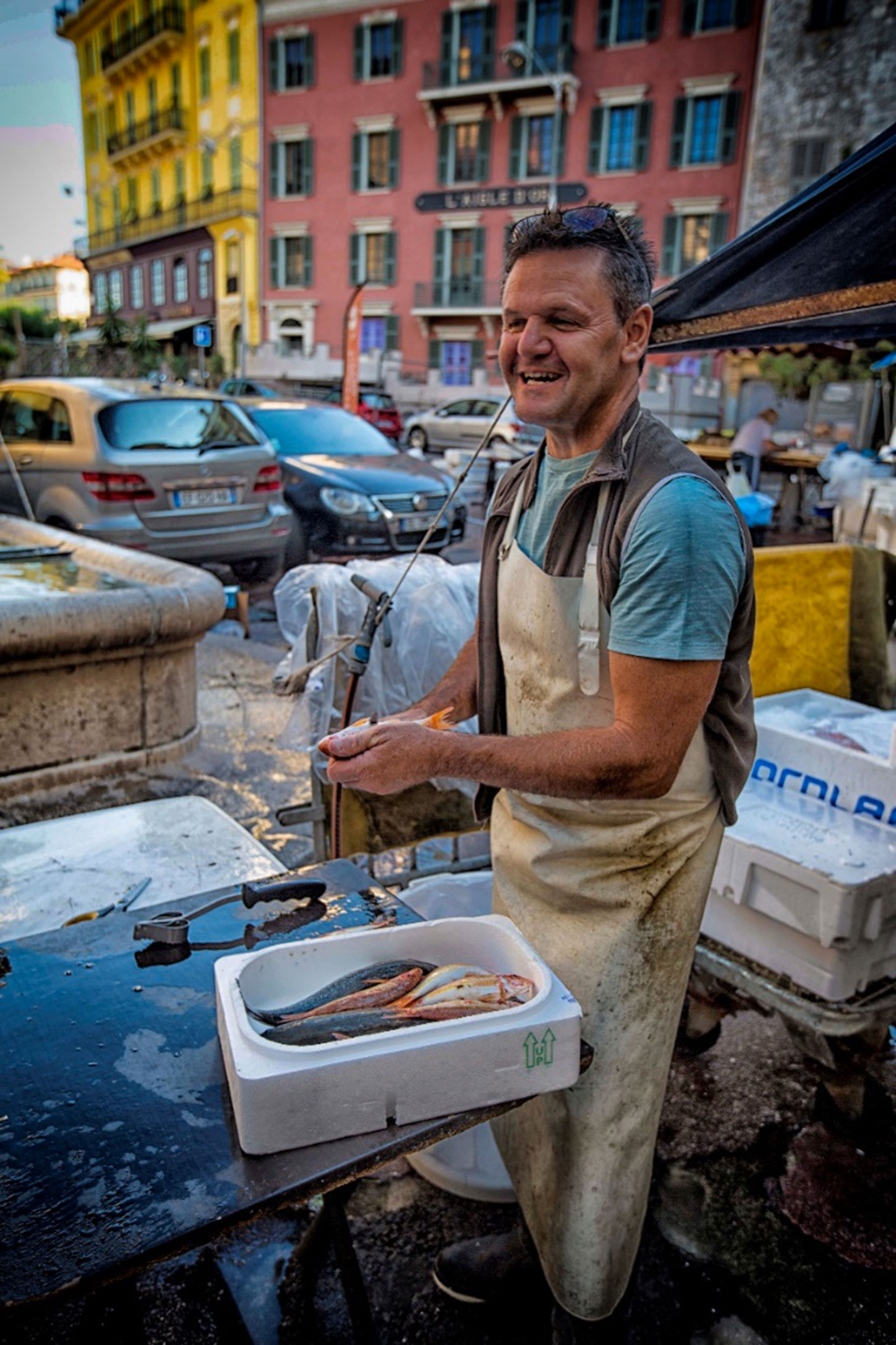Traveller’s Fare

How to eat like a lucky local in Provence
story & photos by François de Mélogue
We arrived in Haut Cagnes Sur Mer dog-tired. At first the old fortified town seemed to repel our advance—there was no straightforward way to our rental by car, and the extremely narrow streets were a complicated maze of one-way signs, do-not-enters, and oh-my-god-we-can’t-possibly-fit-there’s. We circled town a few times trying to find parking before ditching the car and making our way by foot.
I cursed and mumbled as we trudged up the hill, dripping profusely with sweat, laden like an ox carrying a full load, accompanied by a mule of a child who brayed in protest with every step. I had considered selling my soul to the devil in exchange for a quiet pastis in peace, but instead marched forward inch by inch, hoping we’d find our house before morning.
As we neared the 14th century Grimaldi Castle at the top, we could hear loud drunken cheers and smell beautiful wisteria commingled with the licorice scent of pastis, a favorite local aperitif, flowing far too freely. It felt as though my wish had come true—had I entered Provencal heaven?
I love Provence in all her gaiety. We arrived on the night of the annual Championnat du Monde de Boules Carrées, the world’s only square boule (lawn bowling) Championship. The ingenious locals adapted the national pastime of boules to accommodate the town’s steep streets with brightly painted square ‘balls’ and a matching cochonnet that wouldn’t roll several kilometers away when tossed. The narrow streets teemed with crowds heartily drinking and cheering on the three hundred players on, all culminating in a huge party in the town square. It was hard not to join in the revelry, but we still had to find our house.
We finally arrived at our rental, La Maison Cuisinier, and met most of our friends staying with us. Each couple looked slightly shell-shocked, as they’d each experienced their own hellish adventure to get there. We opened several bottles of celebratory rosé wine and sat under the old olive tree on the terrace. A wave of relaxation washed over my body, and the hassles of travelling faded like the last flickers of light from the ochre and lavender colored sky.
The next morning after croissant, sheep milk’s yogurt and a few café au lait, we travelled to nearby vieux Nice (the old town) to walk the narrow cobblestone streets and visit the famous old town fish market. Our rental had a fully functional wood burning oven which we were determined to put to good use. We strolled the pastel colored streets, passing socca stands and food landmarks like Charcuterie Ghibaudo, (founded in 1877 and serving traditional porchetta), Maison Auer (founded in 1820 and specializing in chocolates and candied fruits), and Oliviera (an olive oil store with tastings). We stopped a local to ask where the fish market was and were told to follow the seagulls.
Even when I travel, I prefer to cook at home rather than eating out. I often end up in overpriced tourist traps suffering through mediocre food rather than finding a local gem whose cuisine reflects the region. When I do the cooking myself, I get to interact with locals shopping at the same markets while we all peruse the just-caught fish and fresh vegetables. They are friendly and happy to share recipes, proudly offering tips that help me truly learn their food.
I’d visited Burgundy the week before, where I stopped at a small butcher shop to buy local Charolais beef. The butcher asked what I was cooking so he could better guide me to the best choice. I ended up with the perfect cut of beef and his personal recipe for beef Bourguignonne. It was a wonderful experience that made my trip richer and more meaningful.
It’s interesting to compare shopping in North America and France. For example, when I bought a Bresse chicken at the local Grand Frais supermarket in Beaune, the kid behind the meat counter first asked if I wanted the chicken gutted or whole and then how I was going to prepare it. The question wasn’t intended as small talk like you might find in America, but rather to help the clerk prep the chicken correctly so I wouldn’t have to.
At the Nice fish market, I found beautiful red rouget just caught that morning. The fisherman asked how I was planning to cook them, and when I told him grilled, he quickly gutted the fish leaving the scales on. When grilling, the scales stick to the grill so the fish itself doesn’t. I ended up buying a few wild loup de mer, the freshest calamari I had ever seen, and a couple kilos of local shrimp to eat with aioli as a precursor to lunch.
Next to the fish market was Boucherie St. Francois, an outstanding meat market founded in 1959 by Francois Gasiglia. I picked up a few racks of red labelled Sisteron lamb for grilling. These special Provencal lambs live their short lives on verdant pastures from La Crau to the summits in the Alps, feeding mostly on wild thyme, rosemary and grass. The meat is light pink and very tender, unlike any other lamb you may have eaten. The red label indicates strict standards were followed and full traceability occurred along all the points in the lamb’s life, from pasture to your table. The lambs are milk fed for a minimum of 60 days then left to graze for a brief time longer until reaching the ideal weight of 30 pounds. The label says where the lamb grew up and who its parents were. Sisteron lamb must come from one of three breeds, or a combination thereof: Mérinos d’Arles, Préalpes du Sud and Mourérous.
In the middle of the Cours Saleya outdoor market is Chez Theresa. A Nice tradition since the 1920’s, the café serve socca, freshly made chickpea crepes cooked over a wood fire until crispy which I nibble on while shopping for fresh vegetables and fruits on the way back to our car. I picked up a perfectly ripe and fragrant Charentais melon, a tub of olive and fig tapenade to eat with our lamb, an assortment of fresh farmhouse goat cheeses and the most alluring, deep purple figs I had ever seen. Lunch would be brilliant.
We arrived back in Cagnes Sur Mer completely overloaded with food and ready to cook. After a quick pastis, we fired up the wood burning oven and started to prep lunch. I decided on wood roasted figs wrapped in Iberico ham and kataifi with fresh goat cheese; rouget and ratatouille stuffed in zucchini blossoms; Sisteron lamb roasted with fragrant herbs and drizzled with a fruity olive oil from Vallée de Baux, a region where olives have been growing since 600 BC. While the food cooked, we enjoyed the chilled shrimp dipped in aioli and a glass of rosé.
We ate contentedly for several hours in the warm afternoon sun, each bite a testament to the quality of lamb, seafood and vegetables that can be found in Provence. The counterplay between the salty, aged Spanish ham and the sweet, jammy figs with the textual crunch of kataifi (shredded filo dough) was out of this world. The little tiny rouget stuffed into a zucchini blossom with a spoonful of ratatouille and baked, then just dressed with olive oil was a lesson in refined simplicity. Perfectly roasted lamb chops seasoned with sprigs of rosemary and thyme just picked from the terrace garden and served with a confit of ripe cherry tomatoes, paired with an older Bandol we found in a local wine shop, was superlative. After a simple green salad, we finished with a ripe Banon goat cheese wrapped in chestnut leaves and a few variations of Epoisses (a cheese from Burgundy) left over from the first half of our vacation. It’s gastronomic moments like this that I want never to end.
The sun began to set as we lingered over our last sips of wine before embarking on a leisurely stroll through the quiet streets of Cagnes Sur Mer to the castle. It was lovely to walk past homes with their windows and doors flung wide open, allowing exotic smells and sounds of laughter to escape into the night.
Recipe: Baked Figs with Prosciutto, Kataifi & Lavender Honey
This is the ultimate do-ahead appetizer. Wrap figs the day before your party and bake at the last minute. Making Labne at home is incredibly easy and so much better than the stuff grocery stores sell. To make a two-cup batch, add 1 teaspoon of sea salt to 1000 grams of plain Greek yogurt. Spoon into cheesecloth and hang in your refrigerator for three or four days. Be sure to put a tray underneath to collect the whey that drips off. The yogurt turns into a cream cheese-like texture and tastes great!
Prep time: 15 mins
Cook time: 7 mins
Total time: 22 mins
Serves: 4
- 8 fresh, ripe figs
- 8 slices prosciutto, speck or serrano ham
- ½ box kataifi, shredded filo dough
- 1 stick unsalted butter, melted
- 1 cup labne, house made yogurt cheese
- 4 Tbsp lavender honey
- ¼ cup chopped pistachios
Trim the stems off all the figs and cut a cross into the top using a small paring knife. Wrap the base of each fig with a slice of ham. Mix the melted butter with thawed kataifi and wrap around each fig leaving the top third uncovered. Bake at 450 degrees for seven minutes or until golden brown. Arrange on serving plate, pipe labne onto hot fig, drizzle with melted lavender honey and sprinkle with chopped pistachios.
Find this recipe and more at PistouAndPastis.com.
A former resident of Anderson Valley and Ukiah, Chef François resides in Vancouver, Washington with his wife Lisa and seven-year-old son Beaumont, who has proclaimed himself the family saucier. He has written his first cookbook about Provence, Cuisine of the Sun, and conducts highly personalized, insider culinary adventures of Burgundy/ Lyon, Provence and the Pacific Northwest.




